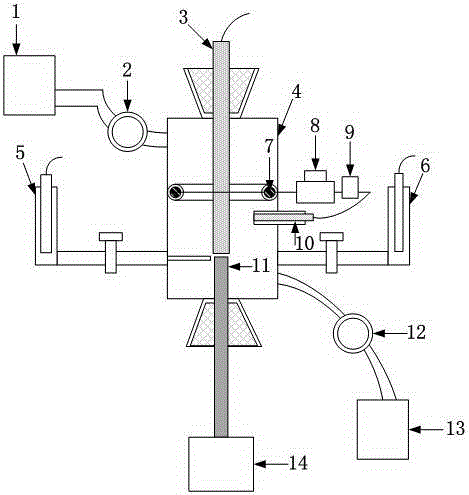Integrated electrolytic tank system and method for in-situ electrochemical mass spectrum detection system
An in-situ electrochemical and mass spectrometry detection technology, applied in the field of electrochemical detection, can solve the problems of three-electrode electrolytic cells that are difficult to diversify, difficult to control temperature observation, etc., and achieve the effect of convenient and quick installation and disassembly, and simple overall operation
- Summary
- Abstract
- Description
- Claims
- Application Information
AI Technical Summary
Problems solved by technology
Method used
Image
Examples
specific Embodiment approach 1
[0021] Specific implementation mode one: as figure 1 As shown, the integrated electrolytic cell system for the in-situ electrochemical mass spectrometry detection system provided in this embodiment consists of three parts: a three-electrode electrolytic cell, an electrolyte replacement device and a built-in temperature control device, wherein:
[0022] The three-electrode electrolytic cell is composed of an auxiliary electrode electrolytic cell 6 , a research electrode electrolytic cell 4 and a reference electrode electrolytic cell 5 , and the research electrode electrolytic cell 4 communicates with the auxiliary electrode electrolytic cell 6 and the reference electrode electrolytic cell 5 respectively.
[0023] The electrolyte replacement device is composed of a liquid storage tank 1, a waste liquid tank 13, a peristaltic pump A2, a peristaltic pump B12 and a connecting pipe. The liquid storage tank 1 is connected to the peristaltic pump A2 through the connecting pipe, and the...
specific Embodiment approach 2
[0041] Specific implementation mode two: In order to detect and study the reaction mechanism of the electrode 3 to the electrooxidation of methanol, the electrode electrolytic cell 4 is injected with 0.5MH 2 SO 4 +0.1MCH 3 OH, auxiliary electrode electrolytic cell 6 and reference electrode electrolytic cell 5 injected with 0.5MH 2 SO 4 , so that the three-electrode electrolytic cell Unicom. Apply a potential to the research electrode 3, perform constant potential adsorption, and then turn on the peristaltic pump A2 and peristaltic pump B12, so that the flow rate of the peristaltic pump is 50mL / min, until the electrolyte flow in the storage tank 1 is the solution volume in the research electrode electrolytic cell 4 5 times or more, start the potential sweep experiment, and measure the mass spectrometry signal through the mass spectrometer inlet at the same time. Afterwards, a resistance wire 7 with a diameter of 1mm is used to spirally place it in a 1cm built-in glass tube,...
specific Embodiment approach 3
[0043] Specific implementation mode three: In order to detect and study the reaction mechanism of the electrode 3 to the electrooxidation of methanol, the electrode electrolytic cell 4 is injected with 0.5MH 2 SO 4 +0.5MCH 3 OH, inject 0.5MH into auxiliary electrode electrolytic cell 6 and reference electrode electrolytic cell 5 2 SO 4 , so that the three-electrode electrolytic cell Unicom. Apply a potential to the research electrode 3, perform constant potential adsorption, and then turn on the peristaltic pump A2 and peristaltic pump B12, so that the flow rate of the peristaltic pump is 200mL / min, until the excess electrolyte flow in the storage tank 1 is the solution volume in the research electrode electrolytic cell 4 5 times or more, start the potential sweep experiment, and measure the mass spectrometry signal through the mass spectrometer inlet at the same time. Afterwards, the resistance wire 7 with a diameter of 1 mm is used to spirally place it in the built-in gl...
PUM
| Property | Measurement | Unit |
|---|---|---|
| Diameter | aaaaa | aaaaa |
| The inside diameter of | aaaaa | aaaaa |
| Diameter | aaaaa | aaaaa |
Abstract
Description
Claims
Application Information
 Login to View More
Login to View More - R&D
- Intellectual Property
- Life Sciences
- Materials
- Tech Scout
- Unparalleled Data Quality
- Higher Quality Content
- 60% Fewer Hallucinations
Browse by: Latest US Patents, China's latest patents, Technical Efficacy Thesaurus, Application Domain, Technology Topic, Popular Technical Reports.
© 2025 PatSnap. All rights reserved.Legal|Privacy policy|Modern Slavery Act Transparency Statement|Sitemap|About US| Contact US: help@patsnap.com

